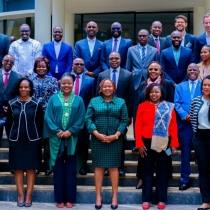
Government Expands Access to Higher Education with UGX 7.25 Billion Student Loan Boost
Uganda’s Higher Education Students’ Financing Board (HESFB) has announced its beneficiaries for the 2024/25 academic year. The UGX 7.25 billion allocated for the student loan scheme will support 1,838 students.
During the announcement at the Uganda Media Centre on Wednesday, September 11, 2024, State Minister for Higher Education, Dr. John Chrysostom Muyingo, emphasized the government's commitment to increasing the reach of the student loan program. He noted a remarkable 246% growth in demand this year, with 6,661 applications received, compared to 1,921 the previous year.
"This year, we have seen a surge in applications, a clear indication that many Ugandans are eager to further their education," said Minister Muyingo. "With the funding we have, we were able to approve 1,838 students, and we are working tirelessly to secure more funds to meet the growing demand."
There is an increased representation of female students among loan recipients this year. Out of the total successful applicants, 43%—790 students—are women, a notable rise from 26% last year. HESFB Executive Director Michael Wanyama highlighted this as a milestone. "We have surpassed the 30% affirmative action target, ensuring more women are able to access higher education," Wanyama said.
Additionally, the loan scheme is promoting inclusivity by supporting 29 Persons with Disabilities (PWDs), allowing both male and female students with disabilities to pursue degrees in science, technology, and the humanities. This push for equitable access is part of a broader strategy by the Board to address educational imbalances across regions.
Focus on STEM and Vocational Education
Minister Muyingo also underscored the government’s focus on Science, Technology, Engineering, and Mathematics (STEM) programs, as well as vocational education, areas he identified as critical to Uganda's developmental and economic goals. "Our priority is to fund programs that will equip our youth with skills to drive the nation forward, especially in the STEM fields," he said.
Out of the 1,838 beneficiaries, 1,372 students (74.6%) will pursue undergraduate degrees, while 466 (25.4%) will enroll in diploma programs, furthering the push towards vocational and technical training.
Equitable Access and Digital Transformation
This year, HESFB introduced a three-tier selection process, assessing applicants based on their socio-economic vulnerability, regional balance, and district quotas. As a result, every district in Uganda is represented, including regions with historically low participation, such as Amudat, Buvuma, and Kotido.
The fully online application process also played a critical role in the success of this year's loan awards. Wanyama praised the digital system for its efficiency, cost-effectiveness, and ability to improve data accuracy, allowing students from across the country to apply without the burden of transportation costs.
Sustaining the Loan Scheme
As the demand for student loans continues to rise, both Minister Muyingo and Eng. Dr. Charles Wana-Etyem, Chairperson of the HESFB Governance Board, reminded beneficiaries of the importance of loan repayment to ensure the sustainability of the fund. "The loans must be repaid so that other students from underprivileged backgrounds can also benefit in the future," Wana-Etyem stressed.
The government is actively working with the Ministry of Finance to increase funding in the coming years, with the aim of expanding the loan program to support even more students.
Eng. Dr. Charles Wana-Etyem notes that the Uganda’s student loan scheme has supported 16,437 students since its inception in 2014.
Links
- 30 views












































Join the conversation